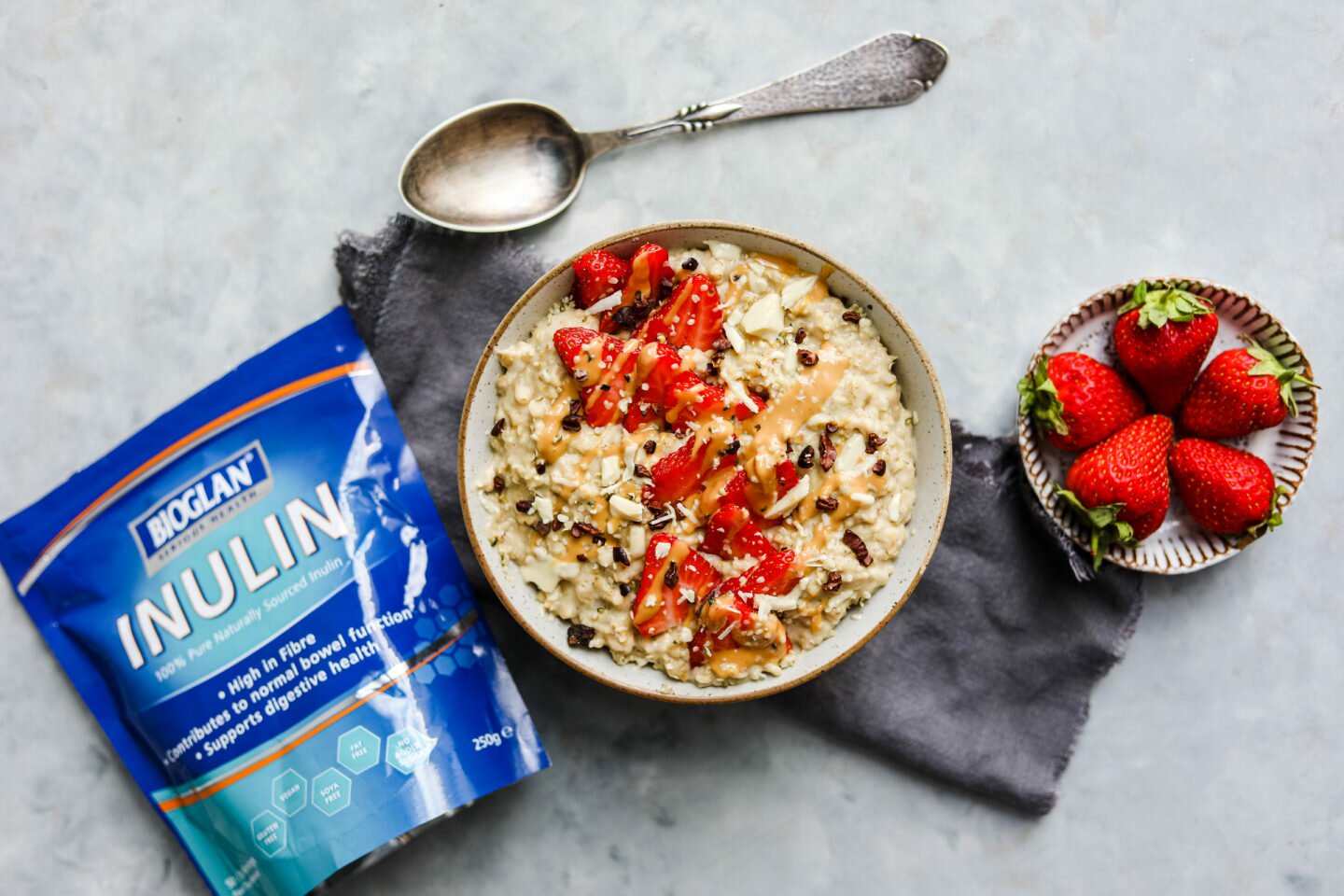I’ve teamed up with Bioglan Supplements to talk about their product Inulin. Inulin is a water-soluble fibre sourced from chicory root which offers a range of health benefits. It is non-digestible so it passes through the stomach, and small intestine, into the large intestine where it is fermented by the gut bacteria, providing the bacteria with the material and energy needed to proliferate and grow.

I took on the task of introducing Inulin to my diet and lifestyle for a 2 week period to then compare the differences. So firstly, how do you incorporate Inulin in to your lifestyle you may ask? Inulin is in powder form and dissolves into liquids. Servings are 1 teaspoon 3 times a day. Which seemed at first like it might be quite tricky to fit into my day, but it couldn’t have been easier. I always begin my day with a big glass of water so the first serving was stirred into this. I have to admit you need to drink the whole glass as soon as you’ve stirred it in because I found that it sunk to the bottom and remained there if you left it. If I wasn’t downing the glass of water which I normally do, I’d simply just keep a spoon in the glass and give it a quick stir each time I drank. My second serving went in either my morning smoothie or porridge super easily as you will see in the photos. And the third I’d add into my dinner if it was something like a curry or chilli. If not into another glass of water. The powder is tasteless too.
Next you may ask, but how did you know if it was doing anything? So, I was kindly sent two microbiome tests from Atlas Biomed whereby they analysed a sample of my stool before I started taking the Inulin and then at the end of the two weeks.

Did I feel any different or notice any changes? Skip forward if you’re not a fan of bowel movement chat. Eating a plant based diet pretty diverse in fruits, vegetables, legumes and grains means my bowel movements are healthy and regular. I noticed that they were probably slightly more frequent across the two week period of taking Inulin. Which I guess is common and as to be expected as I was adding more fibre than usual every day. So I think it shows that the product is great for those who are struggling to fit more fibre into their diet and those who have irregular bowel movements due to the lack of fibre in their diet. I can admit that some weeks I definitely eat a more beige diet and fall short in eating enough veggies and nutrient dense foods. And can notice a negative difference in my body, my energy levels and certainly my bowel movements and digestive wellbeing. I have to admit that I missed a serving on a couple of the days where I was out and about and due to my poor memory. But other than those couple of misses it was easy to fit into my routine!
I was very intrigued as to what the results would show pre and post inulin. Both sets of results showed I had a ‘fairly diverse microbiome that can help to resist the negative impact of external factors’.
My disease risk remained low in both samples which is great news. The main changes in results was the increase in the probiotic bacteria in the microbiome between the two weeks and also Butyrate synthesis had increased. Butyrate (also known as butyric acid) is an essential short-chain fatty acid (SCFA) that is produced from dietary fibre by bacteria in the gut. Therefore dietary fibre must have increased taking Inulin as to be expected. My levels of Vitamin B7 also increased over the two weeks. Vitamin B7 (biotin) regulates blood glucose levels and maintains the skin, hair and nails. It is also involved in hormone synthesis and supporting nervous system functions. Biotin deficiency is rare and has side effects like sagging skin, hair loss and brittle nails. Many foods contain small levels of biotin. The best sources are liver, kidneys, yeast, legumes, cauliflower and nuts.
So positive and interesting results! I am determined to improve the diversity of my microbiome and I will do this making sure I vary the fruit, vegetables, grains and legumes I include in my diet. The results show that the inclusion of Bioglan’s Inulin does what it says on the packet! If you have any underlying or known digestive issues please consult your doctor before introducing Bioglan’s Inulin in to your diet.

I’ve got two recipes to share with you using Bioglan’s Inulin.
First up is:
Blueberry Protein Smoothie
Serves 1
Ingredients
1 teaspoon of Bioglan Inulin
1 teaspoon of smooth peanut butter
1 teaspoon of chia seeds
1 teaspoon of flaxseed
1 scoop/ serving of vanilla protein powder or flavour of choice
55g frozen spinach
120g frozen blueberries
300ml dairy free milk
Granola to top (optional)
Method
- Simply add everything apart from the granola to a blender and blend until smooth.
- Empty into a glass and top with granola should you wish. Enjoy!
Recipe number two:
Vanilla Protein Oats
Serves 1
Ingredients
1 teaspoon of Bioglan Inulin
50g porridge oats
1 serving of vegan vanilla protein powder or protein powder of choice
250ml dairy free milk
fresh sliced strawberries
runny peanut butter
grated dairy free white chocolate
cacao nibs
Method
- In a pan on a medium heat add the oats along with the milk and cook for 8 minutes stirring frequently. Make sure the oats don’t stick to the base of the pan.
- Next add the inulin and protein powder and combine. Add more milk if needed.
- Cook for a further minute before serving in a bowl.
- Top with sliced strawberries, peanut butter, cacao nibs and grated white chocolate. Enjoy!
This was part of a paid partnership.